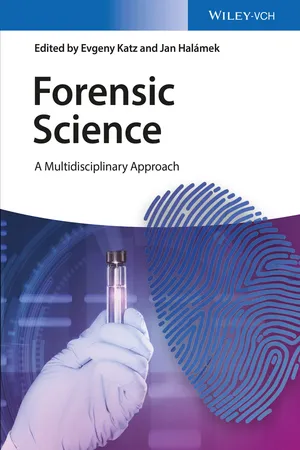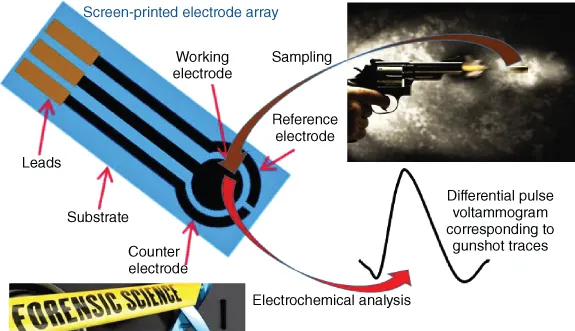
- English
- ePUB (mobile friendly)
- Available on iOS & Android
eBook - ePub
About this book
Concentrating on the natural science aspects of forensics, top international authors from renowned universities, institutes, and laboratories impart the latest information from the field.
In doing so they provide the background needed to understand the state of the art in forensic science with a focus on biological, chemical, biochemical, and physical methods. The broad subject coverage includes spectroscopic analysis techniques in various wavelength regimes, gas chromatography, mass spectrometry, electrochemical detection approaches, and imaging techniques, as well as advanced biochemical, DNA-based identification methods. The result is a unique collection of hard-to-get data that is otherwise only found scattered throughout the literature.
In doing so they provide the background needed to understand the state of the art in forensic science with a focus on biological, chemical, biochemical, and physical methods. The broad subject coverage includes spectroscopic analysis techniques in various wavelength regimes, gas chromatography, mass spectrometry, electrochemical detection approaches, and imaging techniques, as well as advanced biochemical, DNA-based identification methods. The result is a unique collection of hard-to-get data that is otherwise only found scattered throughout the literature.
Frequently asked questions
Yes, you can cancel anytime from the Subscription tab in your account settings on the Perlego website. Your subscription will stay active until the end of your current billing period. Learn how to cancel your subscription.
No, books cannot be downloaded as external files, such as PDFs, for use outside of Perlego. However, you can download books within the Perlego app for offline reading on mobile or tablet. Learn more here.
Perlego offers two plans: Essential and Complete
- Essential is ideal for learners and professionals who enjoy exploring a wide range of subjects. Access the Essential Library with 800,000+ trusted titles and best-sellers across business, personal growth, and the humanities. Includes unlimited reading time and Standard Read Aloud voice.
- Complete: Perfect for advanced learners and researchers needing full, unrestricted access. Unlock 1.4M+ books across hundreds of subjects, including academic and specialized titles. The Complete Plan also includes advanced features like Premium Read Aloud and Research Assistant.
We are an online textbook subscription service, where you can get access to an entire online library for less than the price of a single book per month. With over 1 million books across 1000+ topics, we’ve got you covered! Learn more here.
Look out for the read-aloud symbol on your next book to see if you can listen to it. The read-aloud tool reads text aloud for you, highlighting the text as it is being read. You can pause it, speed it up and slow it down. Learn more here.
Yes! You can use the Perlego app on both iOS or Android devices to read anytime, anywhere — even offline. Perfect for commutes or when you’re on the go.
Please note we cannot support devices running on iOS 13 and Android 7 or earlier. Learn more about using the app.
Please note we cannot support devices running on iOS 13 and Android 7 or earlier. Learn more about using the app.
Yes, you can access Forensic Science by Evgeny Katz,Jan Halámek in PDF and/or ePUB format, as well as other popular books in Medicina & Medicina forense. We have over one million books available in our catalogue for you to explore.
Information
Chapter 1
Forensic Science – Chemistry, Physics, Biology, and Engineering – Introduction
Evgeny Katz and Jan Halámek
The word “forensic” originates from the Latin word forensis, which means public, to the forum, or public discussion. A modern definition of “forensic” is relating to, used in, or suitable to a court of law [1]. Any science used for the purposes of the law is a forensic science. Forensic sciences [2–4] deal with the application of scientific knowledge to legal problems and they are vital tools for unearthing the truth in any legal proceeding. Forensic sciences, including forensic chemistry [5–8], forensic biology [9, 10], forensic anthropology [11], forensic medicine [12], forensic materials science [13, 14], forensic engineering [15], computational forensics [16], and so on, are broadly used to resolve civil disputes, to justly enforce criminal laws and government regulations, and to protect public health.
In some subareas of forensic science, for example, in forensic botany [17], simple observation of plant samples collected at the crime scene could be enough for arriving at important conclusions, while in other forensic methods, such as forensic chemistry, sophisticated instrumental analytical methods are required [18]. The most frequently encountered examples of forensic science applications are fingerprints [19] and DNA analyses [20], both aiming at the identification of crime victims or criminals. However, forensic science methods go much beyond these well-known applications and often include various physical and chemical analytical methods. Vibrational spectroscopy (based on IR absorption and Raman scattering) [21] (Figure 1.1), internal reflection spectroscopy [22], mass spectrometry [23], and electrochemistry [24, 25] (Figure 1.2) have been applied for forensic analyses of human or animal hair, fiber, paints and inks, and a variety of human body fluids, as well as for the detection of gunshot residues, controlled substances (e.g., illicit drugs), explosives, and other chemical and biological agents. Spectral analysis of objects found at the crime scene can be subjected to hyperspectral imaging (HSI) to obtain both spatial and spectral information from the sample [26]. This technique enables investigators to analyze the chemical composition of traces and simultaneously visualize their spatial distribution. HSI offers significant potential for the detection, visualization, identification, and age estimation of forensic traces, also allowing forensic analysis of document forgery [27].

Figure 1.1 Application of vibrational spectroscopy for forensic analysis.
(Reproduced from Muro et al. [21], with permission of American Chemical Society.)

Figure 1.2 Forensic electrochemistry – the electroanalytical sensing of gunshot residues.
A biochemistry-/molecular biology-based subarea of forensic analysis, called forensic serology, deals with the complex task of gathering information on the type of sample, age, origin, or sex from biological fluids (blood, saliva, etc.) found at a crime scene [28]. Analysis of various biomarkers in biofluids found on the crime spot can help in arriving at preliminary conclusions about the race, sex, age, and so on, of possible suspects [29]. DNA typing of criminal suspects or victims can be extended to the DNA analysis of human remains [30], as well as to the analysis of DNA damage and repair in forensic samples [31]. While in most forensic analytical applications the samples collected at the crime scene are sent to a specialized laboratory for sophisticated instrumental analysis, rapid on-site analysis of the recovered samples could be very beneficial for crime investigation; thus, simple biosensors are finding their place in forensic practice [32]. The sensing devices can be miniaturized and ultimately assembled as a wearable fingertip sensor (forensic finger, Figure 1.3), used, for example, for the rapid on-site voltammetric screening of gunshot residues and explosive surface residues [33].

Figure 1.3 Schematic delineating voltammetry of microparticles on a wearable Forensic Finger. (a) The Forensic Finger shows the three electrode surfaces screen-printed onto a flexible nitrile finger cot (bottom left inset), as well as a solid, conductive ionogel immobilized on a similar substrate (top right inset). (b) “Swipe” method of sampling to collect the target powder directly onto the electrode. (c) Completion of the electrochemical cell by joining the index finger with electrodes to the thumb coated with the solid ionogel electrolyte.
(Reproduced from Bandodkar et al. [33], Royal Society of Chemistry. Used under a Creative Commons Attribution 3.0 Unported Licence.)
Forensic analysis of blood stain patterns [34] has become one of the most frequently used and highly important procedures providing key evidence with its ability to potentially map the sequence of events, highlight movement through the crime scene, and identify the minimum number of blows executed. Other materials, particularly left at trace levels, are attracting the attention of forensic investigators, being highly important for the reconstruction of the performed crime [35]. Personal identification methods, for example, based on fingerprints [36], as well as possible complications originating from their spoofing [37] represent an important part of the forensic study.
Various engineering disciplines, including mechanical, electrical, and chemical engineering, fire science, and so on, are also involved in forensic investigations [38, 39], often in civil cases but also in criminal investigations.
This book summarizes the diverse subareas of forensic scie...
Table of contents
- Cover
- Related Titles
- Title Page
- Copyright
- Table of Contents
- List of Contributors
- Preface
- Chapter 1: Forensic Science – Chemistry, Physics, Biology, and Engineering – Introduction
- Chapter 2: Forensic Applications of Vibrational Spectroscopy¥
- Chapter 3: Applications of Internal Reflection Spectroscopy in Forensic Analysis
- Chapter 4: Applications of Mass Spectrometry in Forensic Science: A Brief Introduction
- Chapter 5: An Introduction to Forensic Electrochemistry
- Chapter 6: Electrochemical Detection of Gunshot Residue for Forensic Analysis
- Chapter 7: From Optical to Hyperspectral Imaging Techniques in Forensic Sciences
- Chapter 8: Biochemical Analysis of Biomarkers for Forensic Applications
- Chapter 9: Processing Skeletal Samples for Forensic DNA Analysis
- Chapter 10: DNA Damage and Repair in Forensic Science
- Chapter 11: Biosensors in Forensic Analysis
- Chapter 12: Recent Advances in Bloodstain Pattern Analysis
- Chapter 13: Detection of Cocaine on Paper Currency
- Chapter 14: The Forensic Analysis of Glass Evidence: Past, Present, and Future
- Chapter 15: Forensic Examination of Trace Evidence
- Chapter 16: Fingerprint Spoofing and Liveness Detection
- Chapter 17: Engineering as a Forensic Science
- Chapter 18: Unmanned Systems Technology Use by Law Enforcement
- Chapter 19: Forensic Science – Conclusions and Perspectives
- Index
- End User License Agreement